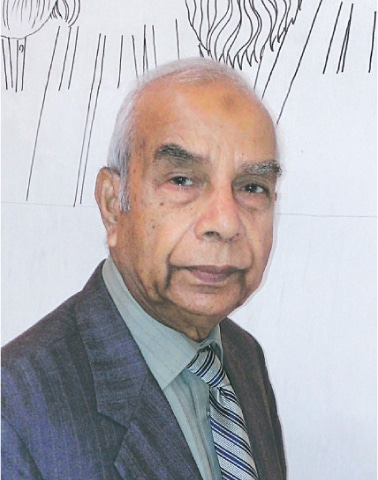Ghazala Anbreen
Aslam Kamal was an eminent painter, calligrapher, illustrator and designer. He was classified as a painter who had the honour of painting Iqbal and Faiz. He Painted Faiz’s “Nuskhah Ha Ay Wafa” in 1983 when the great Poet and thinker was still alive. He studied his poetry in-depth, and developed a relationship with his vocabulary to paint and illustrate with greater understanding. He then painted his philosophy and thought with love and compassion.
He is described as a genius of the contemporary art scenario of Pakistan who was a trendsetter. His figurative paintings, poetic illustrations, calligraphic works, intellectual sketches and book dust covers are a constantly inspiring source for people of all ages, groups and professions.
His fame as a Painter and Calligrapher of the poetry of Allama Iqbal had spread far beyond the boundaries of Pakistan. He exhibited his paintings, calligraphic works and poetic illustrations all over the globe.
In revolutionizing process of calligraphy art in Pakistan, the name we hear after Sadequain is Aslam Kamal. Along with calligraphic Art, Aslam Kamal was also a good novelist, poet and travel book writer. He designed more than 20,000 book covers for which his name has also been recommended for inclusion in the Guinness Book of World Records. He introduced Khat-e-Kamal, his own style of calligraphy, a popular font for Urdu composers.
Dr Saifur Rahman Dar said that Aslam Kamal was a great designer of book dust-covers in the history of Pakistan. His genius was highly acknowledged as a magnificent interpreter of the Poetry of Allama Iqbal through his paintings. In his calligraphic paintings, the pictorial islands ascend from earth towards heaven like blissful prayers and descend from heaven towards earth in the form of revelations.
Though the contemporary art of painting draws its vitality through constant renewal and experimentation with technique, content and form, and calligraphy, the great art of Muslims has been stagnating in conventional modes and needs reinterpretation and a bold approach for its survival. Aslam Kamal’s calligraphy was not less than an art of meditation and his contribution had become popular. It was only the proof of beauty and elegance of the cubistic character of his alphabet. He harked back to the Kufic tradition in calligraphy and the great Islamic architectural tradition in devising his letters. Working from geometric and architectural principles he had given a geometric and cubistic shape to majesty and flexibility.
His choice of colours always used to be in harmony with the import of the words. Usually, his colours were bright and attractive, imparting the right kind of feeling.
Professor Dr Annemarie Schimmel of Harvard University paid tribute to him in the following words,
“I remember how delighted I was when I saw one of his pictures for the first time in the Pakistan Embassy in Bonn. The combination of the letters with geometrical forms, the very delicate colouring and the whole construction of the painting fascinated me and throughout the years has never ceased fascinating me. For, he can combine the simple but powerful geometric shape of the Arabic letters with subtle constructions and it enhances the beauty of the design that everywhere the heritage of Mogul India contains. I would rank him very high as he displays a unique combination of form, meaning and sense of colour”.
At the age of 85, this immensely talented artist left for his heavenly abode on 2 January 2024. In recognition of his meritorious services, he was decorated with the President’s Award for Pride of Performance in 1993. Other awards included a lifetime achievement award by Iqbal Academy Pakistan, Agriculture University Faisalabad, Lahore College for Women University and many other distinguished institutions
In a sitting with him in 2016 he reminisced about his life in the following words:
I was born in Sialkot. This resemblance I bear with Iqbal and Faiz that they too were born in the same region. My elder brother witnessed the movement for Pakistan and also saw the results of that struggle. He used to read aloud the verses of Iqbal at home. In a way, Iqbal is the first person who gave the Muslims the idea of Pakistan. He hints at a pertinent fact that if a movement starts then it does not stop.
I did not have to pass through the steps which some other artists are supposed to. A new artist who wishes to paint Iqbal’s verses is more likely to mark his poems first and tries to learn about the message. Then he will look for the meanings and different shades of his poetry. Chances are there that he may get exhausted during all this.
Iqbal arouses a kind of hatred against slavery in our heart. Then he goes to enthuse a love for freedom. He also invokes heavenly help for this task. He says:
khirad ko ghulami say azad kar,
Jawanon ko peeron ka ustad kar.
In his view, the old people excel in experience and skill but it is the youth who will carry forward this movement. He prays for a new zeal in the heart of the young people.
I used to recall the poetry of Allama Iqbal and it became my habit afterwards. The school I studied in for six years had the verses of Iqbal on its walls and the charts. The centennial celebration of Allama Iqbal was held in 1977. It gave me an opportunity to make my mark and establish my visibility and I was noticed by Faiz Ahmad Faiz as well. Though I was the youngest artist who took part in that exhibition but I was able to prove myself.
In the journey spanning more than forty years I studied, worked hard and got scholarships also. According to the Cultural Institute of Pakistan on Iqbal’s paintings, the maximum work is done by me and I take it as a pride.
After the centennial of Iqbal I painted Faiz Ahmad Faiz Nuskha Haay Wafa and after Faiz’ death I made that more elaborate. My paintings were displayed in the Lister Museum in Bradford and there the exhibition continued for seven months. 2011 was declared as Faiz year. I was, in fact, the only painter who painted Faiz and Iqbal through brush and colour. They are the two poets of our national stream. The first exhibition was held in Lahore, Second in PNCA and the third in PILAC.
I entered in this field through dust over design in 1961. Similarly, Hanif Ramay also entered through same dust cover design art. By 2000 I had prepared over twenty thousand dust covers of different books. Academy of Letters and Urdu Science Board have recommended my name for inclusion in the Guinness Book of World Records for this. And I personally feel that getting recommended itself is an honour for me. Mr Shahnawaz Zaidi, who used to be the Head of College of Art and Design even recommended that one of my books must be translated in English as it is of immense importance. Picasso’s art has been used from twenty to twenty five thousand times for designing different books by different people whereas over twenty thousand people commissioned me for the dust cover designing of their books and I take it as an honour indeed. I made almost 60 to 70 caricatures of famous personalities on the request of Kishwar Naheed for Mah e Nau.
The art of painting is not always deliberate. Sometimes even a wrong stroke of brush makes a painting classic. It is a sad fact that normally it is considered that the prominent Muslim calligraphists were born in Yemen, Iraq and Iran and no credit is given to calligraphists from the Sub Continent. I introduced a new script which is now recognized as Khat e Kamal. It is written in one line. I finished the curves except noon and seen. It can be written from top to bottom, bottom to top, and right to left, from left to right.
I decorated the whole main hall of Academy of Letters’ Head Office in Islamabad showing more than five hundred poets of Pakistan of all languages, the intellectual cosmos of Pakistan. It was painted in a span of two years. It shows the national integration of Pakistan.
I have three travelogues and ten books on my credit. I remained an employee in Secretariat as an artist in 1965. Then I worked in Punjab Agricultural Corporation.
It is unfortunate that the Pakistani artists like Sadequen and Chughtai make no mention in any art dictionary of the world. We remained hockey champions, Cricket champions, and Squash champions. Practically no team of the world could confront us. However, if we try to get rid of the minor differences and stand on one platform, we can regain the lost glory.
*********************************************************

















